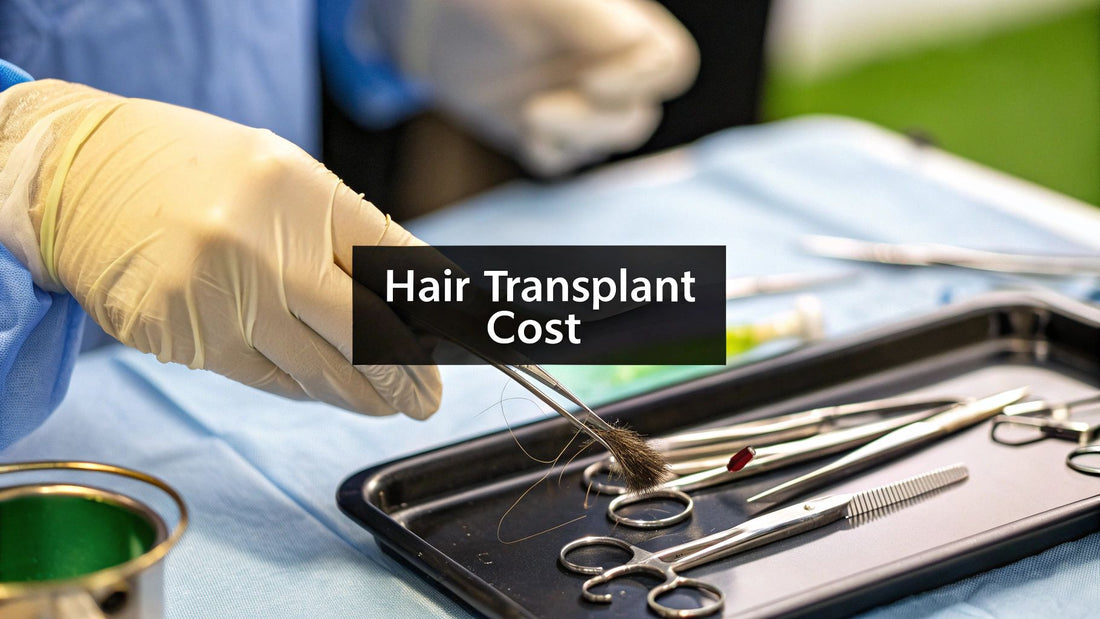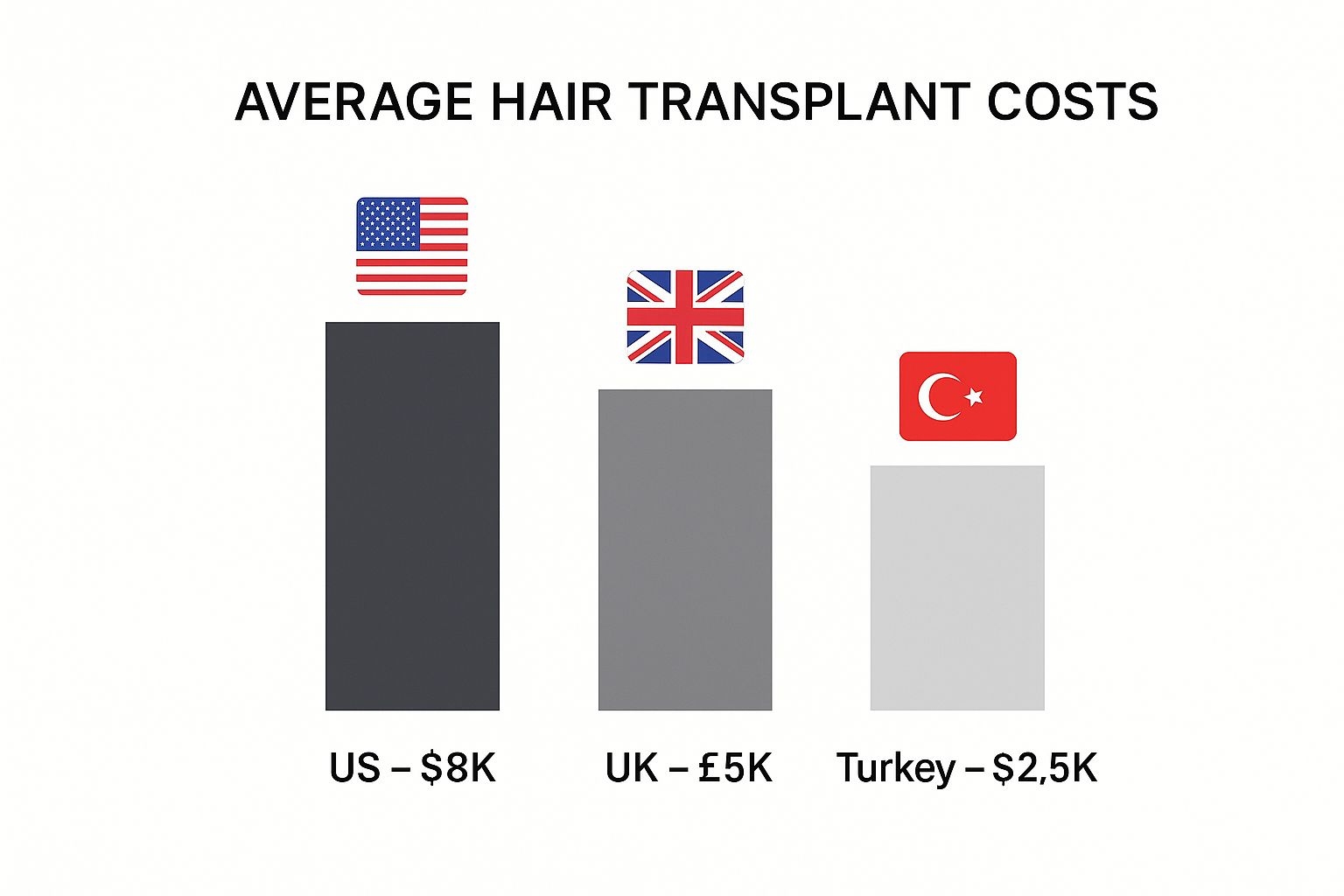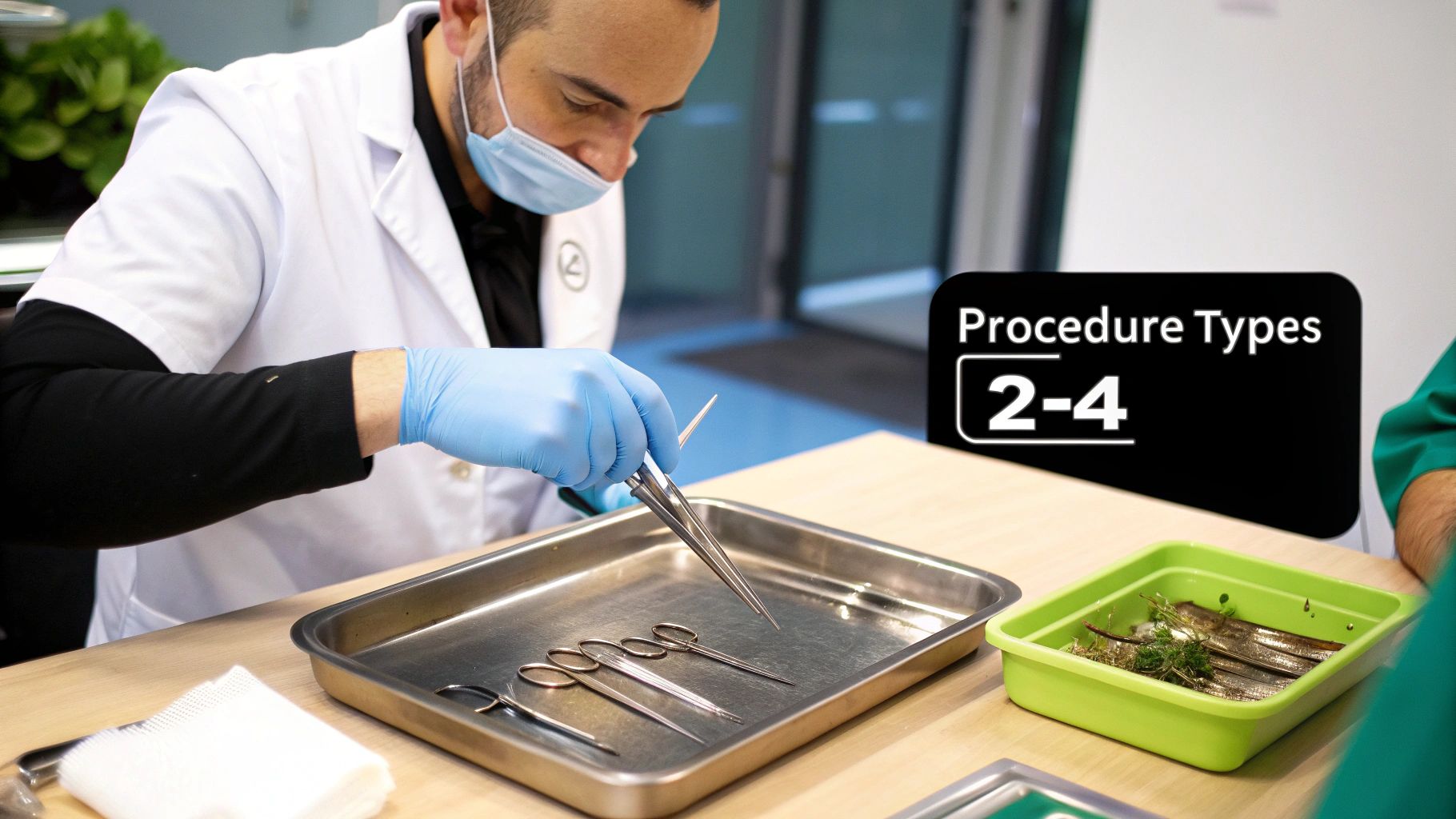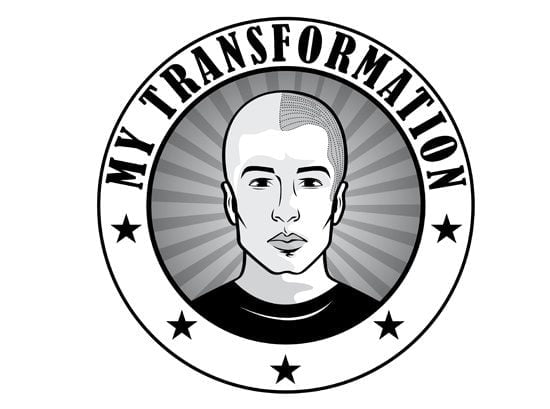
How Much Is Hair Transplant in Australia? Get the Facts
Share
Let's get straight to the point: what's the real cost of a hair transplant in Australia? You can expect to invest anywhere from $5,000 to $18,000, though some extensive procedures can certainly climb higher.
The final figure on your quote boils down to one primary factor: the number of hair grafts you need. It's a bit like retiling a floor—the larger the area you need to cover, the more tiles you'll have to buy.
Your Quick Guide to Australian Hair Transplant Costs
To really get your head around the pricing, you first need to understand what a "graft" is. Think of each graft as a tiny, individual seedling that contains anywhere from one to four hair follicles. The more significant your thinning or balding patch, the more of these seedlings need to be carefully "planted" to achieve the look you're after.
This pay-per-graft model makes things pretty transparent, but it's only the beginning of the conversation. Several other key factors will influence the final cost.
The fundamental principle is simple: the extent of your hair loss dictates the scale of the solution. An in-person consultation is non-negotiable for mapping out the treatment area and getting an accurate graft count.
In Australia, the cost can swing quite a bit depending on the number of grafts and the specific technique the surgeon uses (like FUE or FUT).
Estimated Hair Transplant Cost in Australia by Grafts
Here’s a quick overview to give you a clearer idea of the typical price brackets based on how many grafts you might need.
| Session Size (Graft Count) | Estimated Cost Range (AUD) |
|---|---|
| Small Session (Up to 600 Grafts) | $5,000 - $7,000 |
| Medium Session (1,200 - 2,000 Grafts) | $10,000 - $14,000 |
| Large/Mega Session (Over 3,000 Grafts) | $18,000+ |
As you can see, costs start at around $5,000 for a smaller session, perfect for minor hairline touch-ups. If you're looking at more substantial coverage, a session needing 1,200 to 2,000 grafts will likely fall in the $10,000 to $14,000 range. For those requiring a major restoration with over 3,000 grafts, the investment can easily exceed $18,000.
While these figures give you a solid baseline, it can be helpful to see how they stack up against other cosmetic procedures. Some clinics provide a detailed pricing page that offers a broader perspective on treatment costs.
It's also smart to weigh up this permanent, surgical option against non-surgical alternatives. To get a full financial picture, you might find it useful to read our guide on how much hair replacement systems cost. This will help you compare the one-off investment of a transplant with the recurring costs of other solutions, making sure you choose the path that’s right for you.
What Really Drives the Cost of a Hair Transplant

So, you’re looking at hair transplant quotes and trying to make sense of the final number. To really get it, you need to look past the total and see what’s building that price from the ground up.
The engine driving nearly every quote is the cost-per-graft model. Think of it as the fundamental unit of your procedure's price. It's a bit like buying tiles for a bathroom—you don't just buy "a bathroom's worth"; you calculate the area and figure out how many tiles you need. The same goes for hair grafts; the more scalp you need to cover, the more grafts are required.
But that's just the starting point. The number of grafts is only one part of a much bigger equation. Let's break down the other critical factors that shape the final cost.
The Surgeon and Clinic's Reputation
This is a big one. The skill and experience of your surgeon are probably the most significant factors influencing what you’ll pay. A top-tier surgeon with years of incredible, natural-looking results under their belt is like a master craftsman—their expertise simply costs more.
What are you paying for, exactly? You're investing in years of dedicated training, a deep understanding of how hair grows, and the artistic eye needed to design a hairline that looks completely natural. It's about more than just the procedure itself; it’s about their ability to minimise risks and deliver an outstanding result.
On top of that, clinics that pour money into the latest tech and uphold exceptional standards of care naturally have higher costs, and their pricing will reflect that.
Surgical Technique: FUE vs. FUT
The how of the procedure—the specific technique used to harvest your donor hair—plays a massive role in the final price tag. The two main players here are Follicular Unit Extraction (FUE) and Follicular Unit Transplantation (FUT).
-
Follicular Unit Extraction (FUE): This is a painstaking method where individual hair follicles are extracted one by one from the donor area. It’s incredibly precise but also more time-consuming for the surgical team, which is why it's usually the more expensive choice.
-
Follicular Unit Transplantation (FUT): Often called the "strip method," this technique involves removing a small strip of tissue from the back of the head. The individual follicular units are then carefully separated from this strip under a microscope. Because the harvesting part is quicker, FUT can be a more budget-friendly option, especially for covering larger areas of baldness.
The right choice between FUE and FUT really comes down to your individual situation—your hair type, how much hair you’ve lost, and what your surgeon recommends.
The Scale of Your Hair Loss
It almost goes without saying, but the extent of your hair loss is a huge cost driver. Someone just looking to fill in their temples will need a fraction of the grafts required for someone with significant balding across the top of their head.
Professionals often use a standardised system to classify the extent of hair loss. To get a better idea of how they do this, it’s worth learning what the Norwood Scale is, as it directly helps estimate how many grafts you might need.
This is exactly why a face-to-face consultation is so important. A good surgeon needs to properly assess your scalp, understand your goals, and map out precisely how many grafts are needed to give you the coverage and density you’re hoping for. It’s this personalised plan that ensures your quote is a true reflection of the work involved.
Comparing FUE and FUT: The Two Main Hair Transplant Methods
As you start exploring the world of hair transplants, you'll come across two main techniques: FUE and FUT. These are the two ways a surgeon can harvest the healthy hair follicles needed for the transplant. The method you choose has a big impact on the final cost, what the procedure is like, and how your recovery goes.
FUE vs. FUT: What's the Difference?
Think of your donor area—usually the back of your head—as a lush lawn. The goal is to move some of that healthy grass to the patchy spots.
Follicular Unit Transplantation (FUT), often called the "strip method," is like cutting a neat, thin strip of turf from the lawn. This strip, which is packed with strong hair follicles, is then handed over to a team of technicians. They meticulously separate each individual follicular unit under a microscope, preparing them to be implanted into the areas where your hair is thinning.
On the other hand, Follicular Unit Extraction (FUE) is a more delicate, one-by-one process. Instead of taking a strip, the surgeon carefully extracts each individual follicular unit directly from the scalp. It's a much more labour-intensive and time-consuming approach, which is why FUE procedures typically cost more.
Cost, Scars, and Recovery: The Big Trade-Offs
Because the techniques are so different, they come with their own set of pros and cons. FUT is generally the more budget-friendly option and is often recommended if you need a large number of grafts done in a single sitting. The trade-off is that it leaves a fine, linear scar in the donor area, but this is usually easy to hide as long as you don't wear your hair super short.
FUE is the pricier of the two, but its main advantage is that it avoids the linear scar. Instead, you're left with tiny, dot-like marks scattered across the donor area that are practically invisible, even with a buzz cut. This makes it the go-to choice for guys who like to keep their hair cropped. Recovery can also feel a bit quicker with FUE, with many people reporting less discomfort.
If you'd like to get into the nitty-gritty, you can find out more about what a FUE hair transplant involves in our detailed guide.
The right choice isn't just about the scar. FUT can sometimes yield a higher number of grafts in one go, while FUE gives you more freedom with your hairstyle later on. Ultimately, the "better" procedure really comes down to your personal goals, the extent of your hair loss, and your budget.
To give you a clearer picture, here’s a quick comparison of the two methods.
FUE vs. FUT At a Glance
| Feature | Follicular Unit Extraction (FUE) | Follicular Unit Transplantation (FUT) |
|---|---|---|
| Harvesting Method | Individual follicular units extracted one by one. | A thin strip of tissue is removed from the donor area. |
| Scarring | Tiny, dot-like scars scattered across the donor area. | A single, fine linear scar at the donor site. |
| Best For | Patients who prefer very short hairstyles. | Patients needing a large number of grafts in one session. |
| Cost | Generally more expensive due to the labour-intensive process. | Typically more cost-effective. |
| Recovery | Often quicker with less discomfort in the donor area. | Longer recovery; may involve more tightness or discomfort. |
This table neatly summarises the key differences, helping you weigh the factors that matter most to you.
The infographic below shows just how much location can influence hair transplant costs, with the procedure type being a huge part of that price difference.

As you can see, where you get your procedure done can be just as significant as which one you choose.
Here in a major Australian city like Sydney, for example, those price differences are quite clear. A FUT procedure might set you back between $4,000 and $10,000 AUD, whereas the more meticulous FUE technique usually lands somewhere in the $8,000 to $15,000 AUD range. Many clinics understand this is a big investment and now offer payment plans to make it more accessible.
How Australian Hair Transplant Costs Compare Globally

It’s always a good idea to look at the bigger picture when figuring out the cost of a hair transplant. A quick glance beyond our shores shows that Australian prices are definitely at the premium end of the scale, right up there with other Western countries like the UK and the USA.
That higher price tag isn't for nothing, though. It’s a direct reflection of Australia’s incredibly high medical standards, strict government regulations, and the general cost of running a quality clinic here. You're paying for a level of safety, expertise, and professional accountability that’s baked into our system.
When you put the numbers side-by-side, Australian hair transplants, typically ranging between AUD 6,000 and 12,000, hold their own on the global stage. This pricing mirrors both the quality of care you receive and the operational costs within our healthcare sector. For a deeper dive into what prices might look like in the near future, the Acibadem Beauty Center has put together an interesting 2025 cost breakdown.
The Rise of Medical Tourism
This price difference has given rise to the phenomenon of 'medical tourism,' where people head overseas for cheaper procedures. Places like Turkey and Thailand have become hotspots, often advertising hair transplants for what seems like a steal compared to prices back home.
And let's be honest, the potential savings are tempting. A procedure quoted at $15,000 in Sydney might be advertised for less than $5,000 in Istanbul. But it's crucial to understand that this lower price often comes with significant trade-offs you really need to think about.
While cost is a major factor, the decision shouldn't be based on price alone. A botched hair transplant can lead to permanent scarring, unnatural results, and the need for expensive corrective surgery that far outweighs any initial savings.
Understanding the Risks of Going Overseas
Opting for a cheaper, overseas procedure isn't a simple decision. It comes with some serious risks that you need to weigh up carefully before booking any flights.
- Inconsistent Medical Standards: Not every country holds its clinics to the same rigorous standards as Australia. This can impact everything from basic hygiene to the actual qualifications of the surgeon.
- Lack of Follow-Up Care: The weeks and months after your procedure are critical for success. If you run into any issues once you’re back in Australia, getting help from a clinic thousands of kilometres away can be a nightmare.
- No Legal Recourse: If things go wrong, your ability to seek compensation or hold an overseas clinic accountable is practically non-existent compared to the consumer protections you have here at home.
Ultimately, while an Australian hair transplant is a significant financial decision, that cost buys you peace of mind, high-quality medical care, and the reassurance of having local, accessible support when you need it most.
Financing Your Hair Transplant with Payment Plans
Thinking about a hair transplant is exciting, but let's be honest, the price tag can be a bit of a shock. It's a major investment in yourself, and the upfront cost can feel like a huge hurdle. The good news is, most Australian clinics get it. They've put flexible payment options in place to make the whole process much more achievable for everyday people.
So, the question shifts from "How much does it cost?" to "How can I actually pay for this?". Many clinics offer their own in-house payment plans, which are often the simplest way to go. You’re dealing directly with the clinic, and they’ll help you break down the total cost into smaller, bite-sized payments over a set period.
Exploring Medical Finance Companies
Another very common route is financing through a specialised medical finance company. Most clinics have partnerships with these third-party lenders who focus specifically on funding medical and cosmetic treatments.
It works a lot like getting a loan for a car, but it's tailored for your procedure. These companies will look at your financial situation and offer a structured loan with a clear repayment schedule. This is a popular way to get your transplant done now, rather than waiting years to save up the full amount. To get a better idea of what's out there, you can explore the different hair transplant payment plans clinics often provide.
When you're at your consultation, make sure this is on your list of questions. Don't be shy about asking for the details on their financing partners. Specifically, you'll want to know:
- Interest rates: Is the rate fixed for the life of the loan, or can it change?
- Repayment terms: How long is the loan period? 12 months? 24 months? Longer?
- Any establishment or ongoing fees: Are there any hidden setup costs or account-keeping fees?
Always read the fine print. A low weekly repayment looks great on paper, but you need to understand the total cost over the entire loan term, including every cent of interest and all the fees.
Can Medicare or Private Health Insurance Help?
This is one of the first questions people ask, and unfortunately, the answer is almost always no. Because a hair transplant is considered a cosmetic procedure, it isn't covered by Medicare or your standard private health insurance policy.
There is one very rare exception: accessing your superannuation on compassionate grounds. This is a difficult and complex process. You would need to prove that the procedure is essential to treat a severe mental health condition directly caused by your hair loss, backed by strong evidence from specialists. It’s definitely not a standard or guaranteed option.
The best approach is to be realistic from the get-go. Plan for this to be an out-of-pocket expense and focus on finding a payment plan that comfortably fits your budget.
Uncovering the Hidden and Ongoing Costs

When you first get a quote for a hair transplant, it’s tempting to see that number as the total cost. But that figure is really just the starting point. Think of it like buying a plane ticket—it gets you to your destination, but you still need to budget for the hotel, food, and activities to have a great trip.
The surgery itself is obviously the main expense, but a whole host of smaller, essential costs often aren't rolled into that initial price.
It’s crucial to ask your clinic for a detailed breakdown of what's included. This way, you can build a realistic budget from the get-go and avoid any nasty surprises later on.
Budgeting for Before and After Care
So, what other expenses should you be planning for? Here are a few common ones to get a clearer picture of your total investment:
- Initial Consultation Fees: Some surgeons charge for the first consultation. It's worth asking if this fee gets credited towards your procedure if you decide to go ahead.
- Post-Operative Medications: You'll almost certainly need a course of antibiotics to prevent infection and some pain relief to manage discomfort in the first few days after surgery.
- Specialised Aftercare Products: Your clinic will recommend specific items like gentle shampoos, saline sprays, and sometimes ointments. These are non-negotiable for protecting your new grafts and helping your scalp heal properly.
- Follow-Up Appointments: Most reputable clinics include post-op check-ins as part of their package, but it never hurts to double-check. Confirm that all your follow-up visits are covered.
Thinking of your hair transplant as a one-time expense is a common oversight. The reality is that it's the first step in a long-term strategy to manage your hair loss.
This leads us to the ongoing financial commitment needed to protect your new look. A hair transplant is brilliant at restoring hair to bald areas, but it doesn't stop the natural hair loss process on the rest of your scalp.
To protect your investment and maintain your existing hair, your surgeon will likely recommend ongoing treatments. This often means budgeting for medications like Finasteride or Minoxidil, which are vital for preventing further thinning. Some people also look into how to combine a hair tattoo with a hair transplant as a long-term approach to boost the appearance of density. Factoring in these continuing costs is essential for seeing the complete financial picture.
Your Top Questions About Hair Transplant Costs Answered
It's completely normal to have a lot of questions when you start looking into the financial side of a hair transplant. To help you get a clear picture, we've tackled some of the most common queries that come up.
Think of this as the final piece of the puzzle, designed to clear up any lingering confusion so you can feel confident about what’s involved.
Is a More Expensive Hair Transplant Always Better?
Not at all. While a premium price tag can sometimes reflect a surgeon's extensive experience or a clinic's investment in the latest tech, it's definitely not a guarantee of a better outcome.
What truly matters is finding the right fit for you. The best transplant is one performed safely by a qualified, reputable surgeon who genuinely understands what you're hoping to achieve.
Instead of focusing solely on the price, zero in on these factors:
- The surgeon’s specific credentials and qualifications.
- A solid portfolio of before-and-after photos that show consistent, natural-looking results.
- Positive and verifiable reviews from past patients.
A high quote doesn't promise perfection, and a lower price isn't automatically a red flag. Your main goal should be to find a skilled professional you feel comfortable and confident with.
Why Do Quotes Vary So Much Between Clinics?
It can be surprising to see how widely prices can differ from one clinic to the next, but it usually comes down to a few key things. A surgeon's reputation is a major factor; world-class surgeons with a long history of success will naturally charge more for their expertise.
The clinic's location also plays a big part. Rent and other overheads are simply higher in a bustling city centre, and that cost is often passed on to the patient. The type of technology used and the size of the support team assisting the surgeon also contribute to the final figure.
Always ask for an itemised quote to understand exactly what you're paying for. If you want a broader look at medical pricing, a general healthcare procedure cost calculator can offer some helpful context.
Can I Use My Superannuation to Pay for a Hair Transplant?
This is a tricky one, and in most cases, the answer is no. While you can apply for an early release of super on compassionate grounds, hair transplants are almost always considered a cosmetic procedure.
For an application to even be considered, you'd need to supply significant evidence from medical specialists proving the procedure is critical for treating a severe mental health condition directly caused by your hair loss.
This is a very high bar to clear and isn't a straightforward path. It's absolutely essential to speak with both your super fund and a financial advisor before even thinking about going down this road.
Ready to explore a non-surgical, immediate, and stylish solution for hair loss? At My Transformation, we specialise in Scalp Micropigmentation (SMP), the art of creating the look of a full head of hair. Learn more about how our expert SMP services can restore your confidence today.
